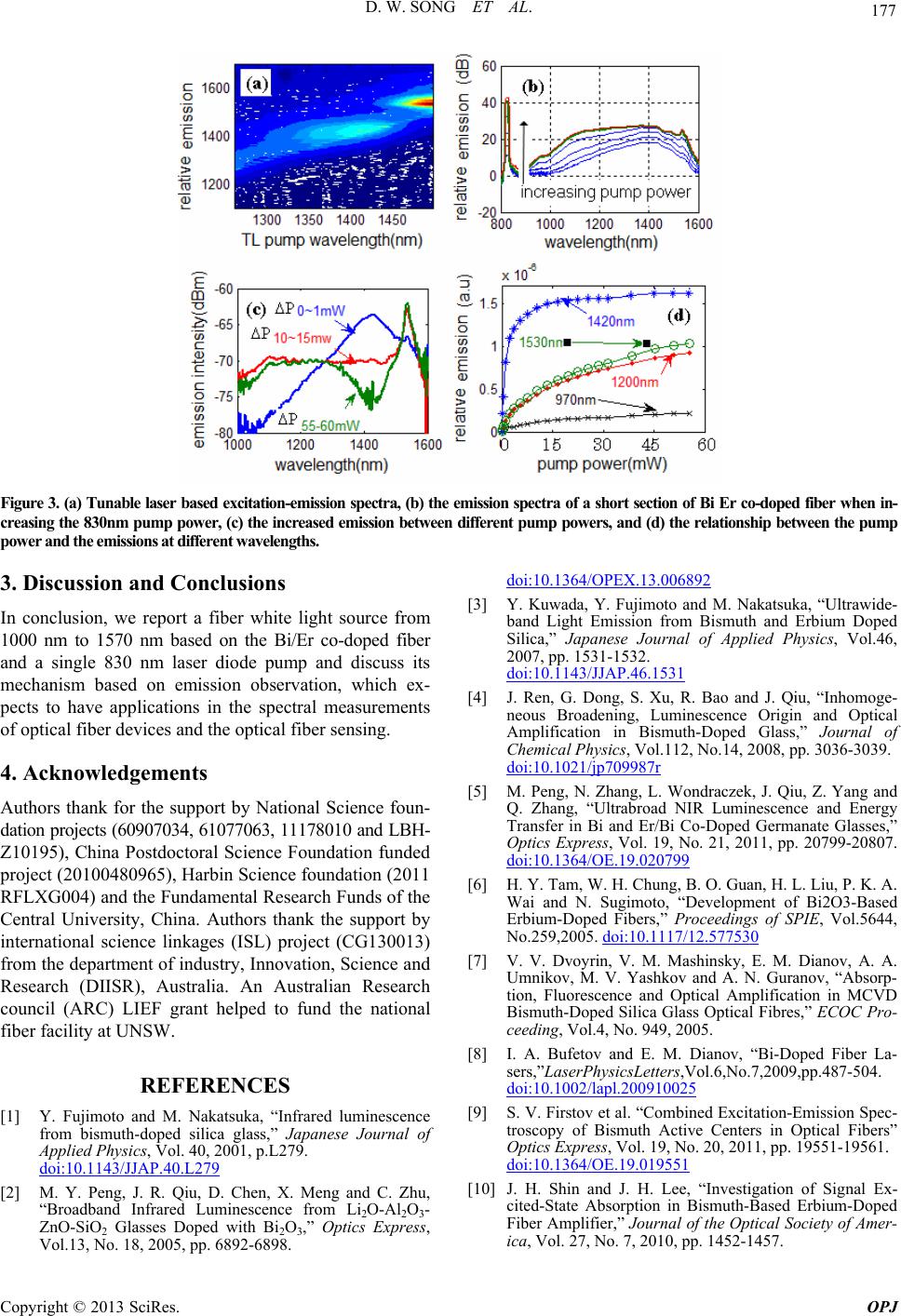
D. W. SONG ET AL. 177
Figure 3. (a) Tunable laser based excitation-emission spectra, (b) the emission spectra of a short section of Bi Er co-doped fiber when in-
creasing the 830nm pump power, (c) the increased emission between different pump powers, and (d) the relationship between the pump
power and the emissions at different wavelengths.
3. Discussion and Conclusions
In conclusion, we report a fiber white light source from
1000 nm to 1570 nm based on the Bi/Er co-doped fiber
and a single 830 nm laser diode pump and discuss its
mechanism based on emission observation, which ex-
pects to have applications in the spectral measurements
of optical fiber devices and the optical fiber sensing.
4. Acknowledgements
Authors thank for the support by National Science foun-
dation projects (60907034, 61077063, 11178010 and LBH-
Z10195), China Postdoctoral Science Foundation funded
project (20100480965), Harbin Science foundation (2011
RFLXG004) and the Fundamental Research Funds of the
Central University, China. Authors thank the support by
international science linkages (ISL) project (CG130013)
from the department of industry, Innovation, Science and
Research (DIISR), Australia. An Australian Research
council (ARC) LIEF grant helped to fund the national
fiber facility at UNSW.
REFERENCES
[1] Y. Fujimoto and M. Nakatsuka, “Infrared luminescence
from bismuth-doped silica glass,” Japanese Journal of
Applied Physics, Vol. 40, 2001, p.L279.
doi:10.1143/JJAP.40.L279
[2] M. Y. Peng, J. R. Qiu, D. Chen, X. Meng and C. Zhu,
“Broadband Infrared Luminescence from Li2O-Al2O3-
ZnO-SiO2 Glasses Doped with Bi2O3,” Optics Express,
Vol.13, No. 18, 2005, pp. 6892-6898.
doi:10.1364/OPEX.13.006892
[3] Y. Kuwada, Y. Fujimoto and M. Nakatsuka, “Ultrawide-
band Light Emission from Bismuth and Erbium Doped
Silica,” Japanese Journal of Applied Physics, Vol.46,
2007, pp. 1531-1532.
doi:10.1143/JJAP.46.1531
[4] J. Ren, G. Dong, S. Xu, R. Bao and J. Qiu, “Inhomoge-
neous Broadening, Luminescence Origin and Optical
Amplification in Bismuth-Doped Glass,” Journal of
Chemical Physics, Vol.112, No.14, 2008, pp. 3036-3039.
doi:10.1021/jp709987r
[5] M. Peng, N. Zhang, L. Wondraczek, J. Qiu, Z. Yang and
Q. Zhang, “Ultrabroad NIR Luminescence and Energy
Transfer in Bi and Er/Bi Co-Doped Germanate Glasses,”
Optics Express, Vol. 19, No. 21, 2011, pp. 20799-20807.
doi:10.1364/OE.19.020799
[6] H. Y. Tam, W. H. Chung, B. O. Guan, H. L. Liu, P. K. A.
Wai and N. Sugimoto, “Development of Bi2O3-Based
Erbium-Doped Fibers,” Proceedings of SPIE, Vol.5644,
No.259,2005. doi:10.1117/12.577530
[7] V. V. Dvoyrin, V. M. Mashinsky, E. M. Dianov, A. A.
Umnikov, M. V. Yashkov and A. N. Guranov, “Absorp-
tion, Fluorescence and Optical Amplification in MCVD
Bismuth-Doped Silica Glass Optical Fibres,” ECOC Pro-
ceeding, Vol.4, No. 949, 2005.
[8] I. A. Bufetov and E. M. Dianov, “Bi-Doped Fiber La-
sers,”LaserPhysicsLe tters,Vol.6,No.7,2009,pp.487-504.
doi:10.1002/lapl.200910025
[9] S. V. Firstov et al. “Combined Excitation-Emission Spec-
troscopy of Bismuth Active Centers in Optical Fibers”
Optics Express, Vol. 19, No. 20, 2011, pp. 19551-19561.
doi:10.1364/OE.19.019551
[10] J. H. Shin and J. H. Lee, “Investigation of Signal Ex-
cited-State Absorption in Bismuth-Based Erbium-Doped
Fiber Amplifier,” Journal of the Optical Society of Amer-
ica, Vol. 27, No. 7, 2010, pp. 1452-1457.
Copyright © 2013 SciRes. OPJ